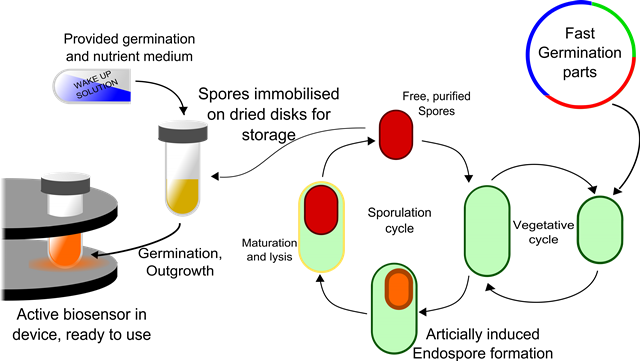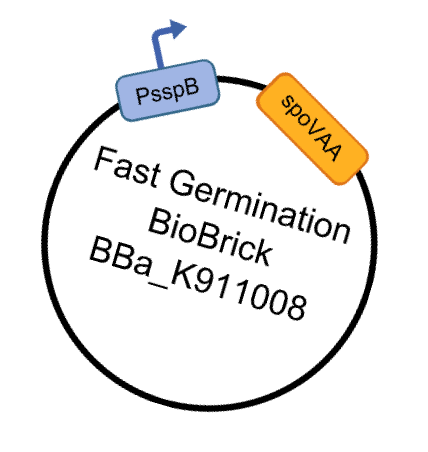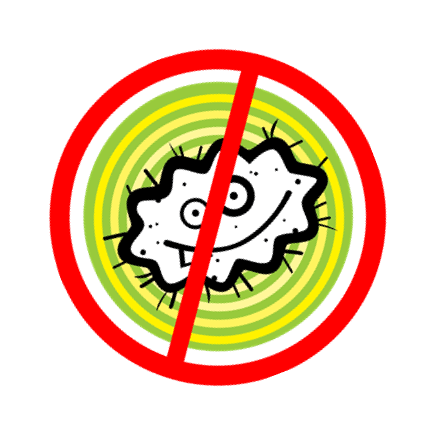Team:Cambridge/SD/Overview
From 2012.igem.org
(→Sporage and Distribution Overview) |
|||
| (16 intermediate revisions not shown) | |||
| Line 60: | Line 60: | ||
=Sporage and Distribution Overview= | =Sporage and Distribution Overview= | ||
| - | The issue | + | ==The issue== |
| + | E.coli has been a popular biosensor chassis to date, however cultures require regular maintenance, or cumbersome and energy intensive freezing processes. To put that last point in context of our human practices drive, there are only two freeze drying facilities in the entirety of Bangladesh. | ||
Conclusion: Long term distribution and hassle-free storage requires a more robust chassis. | Conclusion: Long term distribution and hassle-free storage requires a more robust chassis. | ||
| - | Solution | + | ==The Solution== |
| + | ''Bacillus subtilis'' has the abiltiy to form dormant spores. Tubes of the sporduino sporulated 'sensors' can sit in the user's cupboard, with a generous shelf life, until needed. When the user requires a specific sensor, the appropriate strain is selected and the bacteria can be germinated by following a simple protocol. The tube can then be placed into the arduino device, the test sample loaded and the concentration profile measured. | ||
The 'Sporage and Distribution' module of Sporduino aims to determine a procedure for inducing sporulation in ''Bacillus'', and developing a very simple, user friendly and field worthy protocol for germinating the spores. It is essential for the germination procedure to be as straight forward as possible, requiring minimal equipment and expertise, so that it could in theory be performed in the field, in a situation where the biosensor might be used. | The 'Sporage and Distribution' module of Sporduino aims to determine a procedure for inducing sporulation in ''Bacillus'', and developing a very simple, user friendly and field worthy protocol for germinating the spores. It is essential for the germination procedure to be as straight forward as possible, requiring minimal equipment and expertise, so that it could in theory be performed in the field, in a situation where the biosensor might be used. | ||
| Line 73: | Line 75: | ||
[[File:Sporage and distribution scheme.png|700px|thumb|center|The scheme used to generate, store and use the spores]] | [[File:Sporage and distribution scheme.png|700px|thumb|center|The scheme used to generate, store and use the spores]] | ||
| + | |||
| + | ==Optimisation== | ||
| + | [[File:PSSPB_CONSTRUCT_webr.png|170px|right]] | ||
Germination is a time consuming event. The sooner germination and outgrowth is completed, the quicker the biosensing capability of the system can be implemented, which is the primary goal of sporduino. | Germination is a time consuming event. The sooner germination and outgrowth is completed, the quicker the biosensing capability of the system can be implemented, which is the primary goal of sporduino. | ||
| - | There are several synthetic biology approaches that can be taken to speed up germination. One operon we investigated is the spoVA operon. Upon over expression of spoVA under the germination specific, sspB promoter, germination rates were improved. See the | + | There are several synthetic biology approaches that can be taken to speed up germination. One operon we investigated is the spoVA operon. Upon over expression of spoVA under the germination specific, sspB promoter, germination rates were improved. See the <html><a href="https://2012.igem.org/Team:Cambridge/SD/DesignProcess" style="color:#000066"><u>Design page</u></a></html> for more information about how this was accomplished. |
| + | |||
| + | |||
| + | |||
| + | |||
| + | |||
| + | |||
| + | |||
| + | |||
| + | |||
| + | ==Biocontainment== | ||
| + | [[File:Bioconotainment_webr.png|170px|left]] | ||
| + | |||
| + | Due to time constraints we have deliberately not produced any implemented biocontainment solution. However this is clearly a crucial aspect of the project, if Sporduino was ever to make it into the field. We have instead acknowledged this with two potential solutions: A chemical containment system incorporated into the cuvette, and a genetic 'kill switch'. See the [https://2012.igem.org/Team:Cambridge/SD/DesignProcess Design] page for more details on this. | ||
| + | |||
| + | |||
| + | |||
| + | |||
| + | |||
| + | |||
| + | |||
| + | |||
| + | |||
| + | |||
| - | + | =References= | |
| - | We relied on the following works during the '' 'sporage and distribution' '' | + | We relied on the following works during the '' 'sporage and distribution' '' module. |
| - | + | Sporulation Media : | |
'''Nicholson, W.L., and P.Setlow.''' 1990. Sporulation, germination and outgrowth, p.391-450. 'In' C.R.Harwood and S.M. Cutting (ed.), Molecular biological methods for ''Bacillus''. John Wiley and Sons, Chichester, United Kingdom. | '''Nicholson, W.L., and P.Setlow.''' 1990. Sporulation, germination and outgrowth, p.391-450. 'In' C.R.Harwood and S.M. Cutting (ed.), Molecular biological methods for ''Bacillus''. John Wiley and Sons, Chichester, United Kingdom. | ||
Latest revision as of 02:00, 27 October 2012
Contents |
Judging Form
- Please help the judges by filling out this form. Tell them what medal you think you deserve and why. Tell them which special prizes you should win. Help them find your best parts. Show them how you thought about the safety of your project. Helping the judges will help you too.
- Team: Cambridge
- Region: Europe
- iGEM Year:2012
- Track:Foundational Advance
- Project Name:Parts for a reliable and field ready biosensing platform
- Project Abstract: Implementation of biosensors in real world situations has been made difficult by the unpredictable and non-quantified outputs of existing solutions, as well as a lack of appropriate storage, distribution and utilization systems. This leaves a large gap between a simple, functional sensing mechanism and a fully realised product that can be used in the field.
We aim to bridge this gap at all points by developing a standardised ratiometric luciferase output in a Bacillus chassis. This output can be linked up with prototyped instrumentation and software for obtaining reliable quantified results. Additionally, we have reduced the specialized requirements for the storage and distribution of our bacteria by using Bacillus' sporulation system. To improve the performance of our biosensing platform we have genetically modified Bacillus’ germination speed. Lastly, we demonstrated the robustness of our system by testing it with a new fluoride riboswitch, providing the opportunity to tackle real life problems.
iGEM Medals for non-software teams
- We believe our team deserves the following medal:
- Bronze
- Silver
- √Gold
Because we met the following criteria (check all that apply and provide details where needed)
Requirements for a Bronze Medal
- √Register the team, have a great summer, and plan to have fun at the Regional Jamboree.
- √Successfully complete and submit this iGEM 2012 Judging form.
- √Create and share a Description of the team's project using the iGEM wiki and the team's parts using the Registry of Standard Biological Parts.
- √Plan to present a Poster and Talk at the iGEM Jamboree.
- √Enter information detailing at least one new standard BioBrick Part or Device in the Registry of Standard Biological Parts. Including:
- √Primary nucleaic acid sequence
- √Description of function
- √Authorship
- Safety notes, if relevant.
- √Acknowedgment of sources and references
- √Submit DNA for at least one new BioBrick Part or Device to the Registry.
Additional Requirements for a Silver Medal
- √Demonstrate that at least one new BioBrick Part or Device of your own design and construction works as expected; characterize the operation of your new part/device.
- √Enter this information and other documentation on the part's 'Main Page' section of the Registry
Part Number(s): [http://partsregistry.org/Part:BBa_K911004 BBa_K911004]
Additional Requirements for a Gold Medal: (one OR more)
- Improve an existing BioBrick Part or Device and enter this information back on the Experience Page of the Registry.
Part Number(s): None - √Help another iGEM team by, for example, characterizing a part, debugging a construct, or modeling or simulating their system.
Link to this information on your wiki. Page name: Team:Cambridge/Outreach/Collaboration - √Outline and detail a new approach to an issue of Human Practice in synthetic biology as it relates to your project, such as safety, security, ethics, or ownership, sharing, and innovation.
Link to this information on your wiki.
Page name: Team:Cambridge/HumanPractices/Overview,Team:Cambridge/HumanPractices/MarketResearch,Team:Cambridge/HumanPractices/FutureDirections
iGEM Prizes
All teams are eligible for special prizes at the Jamborees. more... To help the judges, please indicate if you feel you should be evaluated for any of the following special prizes:
- √Best Human Practice Advance
- √Best Experimental Measurement
- Best Model
Please explain briefly why you should receive any of these special prizes:
Best Human Practice Advance:
We feel that we deserve this prize for three reasons:
- We explored the impacts, *both positive and negative*, of synthetic biology as a solution to real world problems, through interviewing professionals working in a relevant field, namely the impact of arsenic water contamination in Bangladesh.
- We recognized existing problems with the way the current direction of synthetic. On going through the registry we found that most of the characterization data for biosensing parts is often neither comparable nor replicable. We have worked to solve this issue, for example with our ratiometric dual channel output.
- *Our project doesn’t stop here*, in Chanel number 6 (Team:Cambridge/HumanPractices/FutureDirections) we considered the future implications and technological applications of our project, as well as the means by which it could be improved by subsequent users. We feel that the end to an iGEM project should not be the conclusion of an idea, but the start of it.
Best BioBrick Measurement Approach:
It is absolutely vital that a quantitative, numerical, robust, and flexible measurement approach exists to relay information to a user that is an accurate representation of the input processed by a biological device. Working from these principles, the following was done:
- We designed and built Biologger, a *cheap, arduino-based, fully functional automatic rotary device* that has an incorporated ratiolumnometer
- Our project is entirely open-sourced and open-platform. We have published source code for the two applications which serve to operate the device, one for PCs and the other for Android devices, as well as the open source circuit design that provides this ratiometric reading. Furthermore, the Android app is able to receive its data wirelessly, which we feel is a great advance in BioBrick measurement.
- Our dual-channel luciferase reporter was successfully tested with a dilution series of E.coli transformed with the Lux Operon (under pBAD) biobrick (Part BBa_K325909) of the Cambridge iGEM 2010 team. It can detect, with good accuracy, both different light intensities, as well as the percentages of blue or orange frequencies in a sample.
- Our device was successfully tested using artificial light to detect different frequencies (colours) as well.
Having done all the above, we believe that this fully open-sourced instrumentation kit (mechanical) chassis, electronics, software code), estimated at *$35.00* (or $85.00 if a Bluetooth modem is required), is a complete BioBrick measurement solution for any and all BioBricks with a light output.
Team_Parts
To help the judges evaluate your parts, please identify 3 of your parts that you feel are best documented and are of the highest quality.
- Best new BioBrick part (natural)
- [http://partsregistry.org/Part:BBa_K911003 BBa_K911003]
- Best new BioBrick part (engineered)
- [http://partsregistry.org/Part:BBa_K911004 BBa_K911004]
- Best improved part(s): None
List any other parts you would like the judges to examine:[http://partsregistry.org/Part:BBa_K911001 BBa_K911001], [http://partsregistry.org/Part:BBa_K911008 BBa_K911009], [http://partsregistry.org/Part:BBa_K911008 BBa_K911008]
Please explain briefly why the judges should examine these other parts:
- Magnesium Sensitive Riboswitch [http://partsregistry.org/Part:BBa_K911001 BBa_K911001]
As a riboswitch sensing construct, this part is an entirely new type of biosensor (along with the fluoride construct) that could potentially change the way we think about designing input genetic circuits. Unlike the fluoride riboswitch, it is a derepression system and therefore serves to demonstrate the principle that riboswitches can be used regardless of whether they turn on or off their reporter. - Fluorescent ratiometric construct for standardizing promoter output [http://partsregistry.org/Part:BBa_K911009 BBa_K911009]
Fluorescence is a major cornerstone for biosensors in the registry, however, most parts do not involve the use of a ratiometric output, which has been shown in the literature to provide much more reliable and meaningful data. This part not only furthers the development of ratiometric measurements in molecular biology but due to the choice of promoters and terminators it can be used to characterize the difference in activity between E. coli and B. Subtilis - Fast Germination (B. subtilis) [http://partsregistry.org/Part:BBa_K911008 BBa_K911008]
This part is entirely novel for the registry and fully utilizes the recombination machinery inherent in the Bacillus chassis. Have spores that can germinate at a faster rate is certainly a worthy achievement and could help with experiments with B. Subtilis that any future iGEM teams may wish to perform.
iGEM Safety
For iGEM 2012 teams are asked to detail how they approached any issues of biological safety associated with their projects.
The iGEM judges expect that you have answered the four safety questions Safety page on your iGEM 2012 wiki.
Please provide the link to that page: Page name: Team:Cambridge/Safety
Attribution and Contributions
For iGEM 2012 the description of each project must clearly attribute work done by the team and distinguish it from work done by others, including the host labs, advisors, and instructors.
Please provide the link to that page, or comments in the box below: Page name: Team:Cambridge/Attributions
Comments
If there is any other information about your project you would like to highlight for the judges, please provide a link to your wiki page here: Team:Cambridge/Overview/DesignProcess
Sporage and Distribution Overview
The issue
E.coli has been a popular biosensor chassis to date, however cultures require regular maintenance, or cumbersome and energy intensive freezing processes. To put that last point in context of our human practices drive, there are only two freeze drying facilities in the entirety of Bangladesh.
Conclusion: Long term distribution and hassle-free storage requires a more robust chassis.
The Solution
Bacillus subtilis has the abiltiy to form dormant spores. Tubes of the sporduino sporulated 'sensors' can sit in the user's cupboard, with a generous shelf life, until needed. When the user requires a specific sensor, the appropriate strain is selected and the bacteria can be germinated by following a simple protocol. The tube can then be placed into the arduino device, the test sample loaded and the concentration profile measured.
The 'Sporage and Distribution' module of Sporduino aims to determine a procedure for inducing sporulation in Bacillus, and developing a very simple, user friendly and field worthy protocol for germinating the spores. It is essential for the germination procedure to be as straight forward as possible, requiring minimal equipment and expertise, so that it could in theory be performed in the field, in a situation where the biosensor might be used. For further information, refer to our Design process page and our Results page.
Optimisation
Germination is a time consuming event. The sooner germination and outgrowth is completed, the quicker the biosensing capability of the system can be implemented, which is the primary goal of sporduino.
There are several synthetic biology approaches that can be taken to speed up germination. One operon we investigated is the spoVA operon. Upon over expression of spoVA under the germination specific, sspB promoter, germination rates were improved. See the Design page for more information about how this was accomplished.
Biocontainment
Due to time constraints we have deliberately not produced any implemented biocontainment solution. However this is clearly a crucial aspect of the project, if Sporduino was ever to make it into the field. We have instead acknowledged this with two potential solutions: A chemical containment system incorporated into the cuvette, and a genetic 'kill switch'. See the Design page for more details on this.
References
We relied on the following works during the 'sporage and distribution' module.
Sporulation Media :
Nicholson, W.L., and P.Setlow. 1990. Sporulation, germination and outgrowth, p.391-450. 'In' C.R.Harwood and S.M. Cutting (ed.), Molecular biological methods for Bacillus. John Wiley and Sons, Chichester, United Kingdom.
The Fast Germination BioBrick was based on the construct used in:
Wang, G., Yi, X., Li, Y.-Q., Setlow, P. Germination of individual Bacillus subtilis spores with alterations in the GerD and SpoVA proteins, which are important in spore germination(2011) J. Bacteriology, 193 (9), pp. 2301-2311.
Details of design of the construct were found in:
Cabrera-Martinez, R.-M., F. Tovar-Rojo, V. R. Vepachedu, and P. Setlow. 2003. Effects of overexpression of nutrient receptors on germination of spores of Bacillus subtilis. J. Bacteriol. 185:2457-2464.
Paidhungat, M., and P. Setlow. 2001. Localization of a germinant receptor protein (GerBA) to the inner membrane of Bacillus subtilis spores. J. Bacteriol. 183:3982-3990.
 "
"


